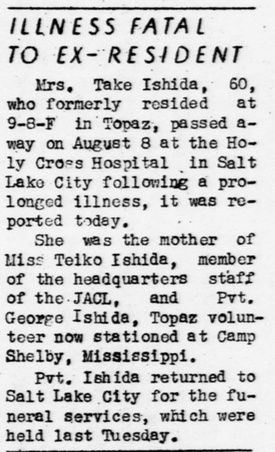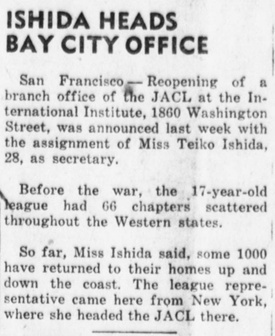In September 1943, the Japanese American Citizens League announced that Mike Masaoka, George Inagaki, JACL membership director, and Joe Kanazawa, the JACL’s Eastern Representative, had enlisted in the U.S. Army and left their JACL positions. The JACL then selected Ishida as acting National Secretary for the east, and sent her to open a new office at 299 Madison Ave. in New York City. (For a time Ishida, along with the Tajiris, was the JACL’s only paid employee).
During her tenure as acting national secretary, Ishida undertook several further initiatives to promote the name of the JACL. She worked with the National Japanese American Relocation Council to help bring more students to New York City, arguing that parents would leave camp to follow their children to cities near their colleges. Throughout her time in New York, she made monthly trips to Washington, D.C. to meet with government officials about issues facing Japanese Americans.
Most significantly, Ishida engaged in an intense writing campaign to promote Japanese Americans. On March 6, 1944, the New Republic published a letter to the editor written by Ishida, representing the JACL. Ishida praised the government’s decision to create an all-Japanese American combat unit, and meanwhile used her letter to promote the JACL’s mission of “integration and assimilation” by suggesting that readers subscribe to the The Pacific Citizen.
Ishida’s letter sparked a debate between her and a Nisei graduate student, Kazuyuki Takahashi. Takahashi argued in a separate letter that the JACL, while influential, did not represent of the whole community, and exhorted readers to remember that the cause of the incarceration was government racism, not lack of patriotism on the part of Japanese Americans. Returning to the question of “No-Nos,” Ishida softened her previous position. She wrote a letter to the War Relocation Authority on April 13, 1944 stating that the JACL still considered any individuals who had responded no to question 28 as United States citizens.
On April 30, 1944, the New York Herald Tribune ran an article spotlighting Teiko Ishida and her work for the JACL. Written following a report of a chance conversation between Ishida and an Army officer ignorant of Japanese Americans, the article attempted to dispel racist notions of Japanese Americans as mindless or prejudiced (and short!). Ishida shared several touching tales, including one of her bringing her mother’s ashes to San Francisco in August 1943 under the guard of a WRA officer. The author, Dorothy Dunbar Bromley, called on Mayor Fiorello LaGuardia to read about Ishida’s story, in light of his comments opposing Japanese American resettlement in New York.
Ishida also masterminded the reopening of the JACL offices in San Francisco. On September 16, 1944, the Manzanar Free Press stated that Ishida had consulted with General Charles H. Bonesteel, the Western Defense Commander, about allowing more Japanese Americans to return to the West Coast. In December 1944, she received personal clearance by General Bonesteel to come to San Francisco in anticipation of the lifting of exclusion.
During this time, she was hired as an assistant by Reverend Howard Thurman of the Fellowship Church, thereby allowing her to pay her bills. (For more information, see Greg Robinson and Peter Eisenstadt’s article on Thurman). As part of her mission to open the San Francisco office, Ishida drafted several grant applications that were sent to institutions such as the Carnegie Endowment for International Peace, the Field Foundation, and the Columbia Foundation. In total, Ishida raised $11,000 in funds for the new office, plus a grant from the Rosenberg Foundation of $6000 awarded in June 1945.
Following the ruling of Ex Parte Endo on December 17, 1944, the U.S. Army lifted the exclusion of Japanese Americans from the West Coast on January 2, 1945. The next day, Teiko Ishida opened the new JACL national headquarters in San Francisco, although the Pacific Citizen and various functions remained in Salt Lake City.
In the days that followed, Ishida assured reporters that families would return to the West Coast, but did not expect them to do so immediately due to housing shortages. On January 28, Ishida spoke with the Associated Press about the return of Japanese Americans to the West Coast, stating that while most Japanese Americans were fearful of violence, such return should still be encouraged. She also called on the WRA to assist with finding new housing for families.
Despite her dynamism, Ishida suffered from chronic medical problems. On June 21, 1945, the JACL announced Ishida’s resignation as acting national secretary for health reasons. President Saburo Kido applauded Ishida’s record as a master fundraiser for the JACL and for her leadership in moving the JACL headquarters to San Francisco in January 1945. Nonetheless, the JACL leaders continued to hold sexist views. UC Berkeley International House Director Allen Blaisdell, along with a representative from the Rosenberg Foundation, wrote to Saburo Kido asking for Ishida to be replaced by an “effective man” due to her health. Replacing Ishida was Mike Masaoka’s brother, Joe Grant Masaoka.
One of her last initiatives as acting national secretary was to lobby the U.S. Army to bring the 442nd Regimental Combat Team to the West Coast for publicity. Although Assistant Secretary of War John J. McCloy responded with interest to Ishida’s request, the Army eventually decided not to do so in the wake of Japan’s surrender in August 1945, and assigned the 442nd to occupation duties in Europe.
In December 1945, Ishida married Michael “Mickey” Kuroiwa. Originally from Mesa, Arizona, Kuroiwa avoided incarceration and enlisted in the Military Intelligence Service. He later entered the grocery business, and worked as a controller of Littleman Grocers in San Francisco. During the postwar years, Teiko remained active as a regular volunteer at the JACL headquarters, and served on the panel for several national scholarships.
In September 1958, the JACL awarded Teiko a ruby pin at the National Biennium in recognition of her service. She worked as a fundraiser for Hawaii Senator Daniel Inouye’s campaign in San Francisco in 1962. In January 1963, she helped form the United Committee for the Japanese Community, which oversaw the A-2 project, a redevelopment of Nihonmachi in the Western Addition, but left in April 1963 due to personal reasons. She died on May 1, 1998 at the age of 82.
As part of the skeleton crew that managed the JACL during the war, Teiko Ishida provided important guidance for the organization. Ishida’s views on the need for Japanese Americans to assimilate and demonstrate their loyalty underscore her grand expectations of the community despite its adverse circumstances. Perhaps one of the great lessons that can be learned from the life of Teiko Ishida is that of the tenacity she showed in developing her own career, despite the gender roles imposed upon her.
In Teiko’s case, she doggedly rose to the top of the JACL at one of its most critical junctures and helped connect the organization with the general public. As evidenced by the letters and newspapers addressing her as “Mr. Teiko Ishida,” her stalwart work at the higher ranks of a community organization befuddled journalists and government officials alike into misgendering her. Teiko’s story is an important reminder of the contribution of women to building and forging community institutions.
© 2022 Jonathan van Harmelen








